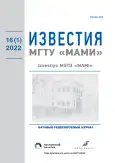Forecasting the magnitude of the electrical load in electrical complexes of aircraft
- Authors: Chernov A.E.1, Maleev R.A.2, Eroshkin D.A.1, Fedorenko E.N.2
-
Affiliations:
- Military Academy of Strategic Missile Forces named after Peter the Great
- Moscow Polytechnic University
- Issue: Vol 16, No 1 (2022)
- Pages: 99-106
- Section: Electrotechnical facilities and systems
- URL: https://journals.rcsi.science/2074-0530/article/view/107124
- DOI: https://doi.org/10.17816/2074-0530-107124
- ID: 107124
Cite item
Full Text
Abstract
BACKGROUND: The issue of forecasting, analysis and control of electrical load becomes more significant both within the framework of the electrical complex of the summer apparatus as a whole, and for certain groups of electric energy consumers. Forecasting the electrical load is necessary to solve the problem of optimizing the operational state of an electrical complex or system, under constantly changing conditions and changing environment, which entails a change in power. Recently, a relatively new method has often been used, which is based on fuzzy logic. This method is a symbiosis of fuzzy logic and neural networks, which includes the main properties characteristic of these areas. Thanks to the use of a well-established fuzzy neural technology implemented in a correctly designed and trained fuzzy neural network for predicting electrical loads, it became possible to ensure sufficiently high accuracy and speed of load prediction.
AIMS: The purpose of the work is to analyze methods for predicting the electrical load of the aircraft’s electrical and technical complex, as well as to determine the most optimal methodology for predicting the electrical load of an autonomous aircraft used in the armed forces.
METHODS: Modeling of working conditions is performed in the Matlab program and its applications – Simulink. At the same time, with the help of the fundamental blocks of this application, models of the physical components of the electrical complex of the aircraft are created.
RESULTS: For a substantive assessment of the prediction of the magnitude of the electrical load of the electrical complex of the aircraft, an algorithm implemented on a computer has been developed. It provides for the implementation of retrospective calculations taking into account the amount of power generated, the duration of operation and the flow of electricity in the electrical complex as a whole.
CONCLUSIONS: Due to the use of a well-established fuzzy neural technology for predicting electrical loads, implemented in a correctly designed and equipped fuzzy neural network, it became possible to provide the necessary accuracy and speed of predicting electrical loads.
Full Text
##article.viewOnOriginalSite##About the authors
Alekcander E. Chernov
Military Academy of Strategic Missile Forces named after Peter the Great
Email: chae-1966@yandex.ru
Associate Professor, Dr. Sci. (Engin.), Department of «Power Supply of Missile Systems»
Russian Federation, 143900, Балашиха, ул. Карбышева, д. 8Ruslan A. Maleev
Moscow Polytechnic University
Email: 19rusmal@gmail.com
ORCID iD: 0000-0003-3430-6406
SPIN-code: 7801-3294
Professor, Cand. Sci. (Engin.) Department of Electrical Equipment and Industrial Electronics
Russian Federation, MoscowDmitry A. Eroshkin
Military Academy of Strategic Missile Forces named after Peter the Great
Email: Demka212010@mail.ru
ORCID iD: 0000-0001-5052-2761
Adjunct, Department of «Power Supply of missile systems»
Russian Federation, 143900, Балашиха, ул. Карбышева, д. 8Elena N. Fedorenko
Moscow Polytechnic University
Author for correspondence.
Email: rifan2008@yandex.ru
ORCID iD: 0000-0001-9351-8228
SPIN-code: 5316-8683
Senior Lecturer Department of Electrical Equipment and Industrial Electronics
Russian Federation, MoscowReferences
- Charytoniuk W, Chen MS. Short-term Forecasting in Power Systems Using a General Regression Neural Network. IEEE Transactions on Power Systems. 1995;7(1).
- Gordeev VI, Vasil’ev IE, Shchutskii VI. Upravlenie elektropotrebleniem i ego prognozirovanie. Rostov-on-Don: Izdatel’stvo Rostovskogo universiteta; 1991. (In Russ).
- Bunn DH, Farmer ED. Comparative models for electrical load forecasting. Moscow: Energoatomizdat, 1987. (In Russ).
- Srinivasan D, Tan SS, Chang CS, Chan EK. Practical implementation of a hybrid fuzzy neural network for one-day-ahead load forecasting. IEE Proceedings – Generation, Transmission and Distribution. 1998;145(6):687–692. doi: 10.1049/ip-gtd:19982363
- Leonenkov AV. Nechetkoe modelirovanie v srede MATLAB i fuzzy TECH. Saint Petersburg: BKhV-Peterburg; 2003. (In Russ).
- Gordeev VK, Nadtoka II. Vzaimnaya korrelyatsiya v raschetakh kharakteristik grafikov elektricheskoi nagruzki. Elektrichestvo. 1978;(8):17-21. (In Russ).
- Gordeev VI. Raschet dispersii grafikov elektricheskoi nagruzki. Elektrichestvo. 1971;(10):86–88. (In Russ).
- Alekseeva IY, Stepanov VP, Vedernikov AS. Metod eksponentsial’nogo sglazhivaniya linii trenda vremennogo ryada v sochetanii s metodom indeksov sezonnosti pri kratkosrochnom prognozirovanii elektropotrebleniya. Vestnik Samarskogo gosudarstvennogo tekhnicheskogo universiteta. Seriya: Tekhnicheskie nauki. 2008;(1):137–143. (In Russ).
- Lukashin YG. Adaptivnye metody kratkosrochnogo prognozirovaniya. Moscоw: Statistika; 1972. (In Russ).
- Gordeev VI, Vasil’ev IE, Shutskii VI. Upravlenie elektropotrebleniem i ego prognozirovanie. Rostov-on-Don: Izd-vo RGU; 1991. (In Russ).
Supplementary files











